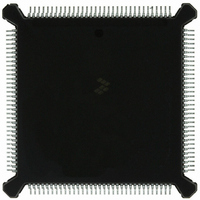MC68332GCEH16 Freescale Semiconductor, MC68332GCEH16 Datasheet - Page 103

MC68332GCEH16
Manufacturer Part Number
MC68332GCEH16
Description
IC MCU 32BIT 16MHZ 132-PQFP
Manufacturer
Freescale Semiconductor
Series
M683xxr
Specifications of MC68332GCEH16
Core Processor
CPU32
Core Size
32-Bit
Speed
16MHz
Connectivity
EBI/EMI, SCI, SPI, UART/USART
Peripherals
POR, PWM, WDT
Number Of I /o
15
Program Memory Type
ROMless
Ram Size
2K x 8
Voltage - Supply (vcc/vdd)
4.5 V ~ 5.5 V
Oscillator Type
Internal
Operating Temperature
-40°C ~ 85°C
Package / Case
132-QFP
Cpu Family
68K/M683xx
Device Core
ColdFire
Device Core Size
32b
Frequency (max)
16MHz
Interface Type
QSPI/SCI/UART
Program Memory Size
Not Required
Total Internal Ram Size
2KB
# I/os (max)
15
Number Of Timers - General Purpose
16
Operating Supply Voltage (typ)
5V
Operating Supply Voltage (max)
5.5V
Operating Supply Voltage (min)
4.5V
Instruction Set Architecture
RISC
Operating Temp Range
-40C to 85C
Operating Temperature Classification
Industrial
Mounting
Surface Mount
Pin Count
132
Package Type
PQFP
Controller Family/series
68K
No. Of I/o's
15
Ram Memory Size
2KB
Cpu Speed
16MHz
No. Of Timers
16
Embedded Interface Type
QSPI, SCI, UART
Digital Ic Case Style
PQFP
Rohs Compliant
Yes
Processor Series
M683xx
Core
CPU32
Data Bus Width
32 bit
Data Ram Size
2 KB
Maximum Clock Frequency
16 MHz
Number Of Programmable I/os
15
Number Of Timers
16
Maximum Operating Temperature
+ 85 C
Mounting Style
SMD/SMT
Minimum Operating Temperature
- 40 C
Lead Free Status / RoHS Status
Lead free / RoHS Compliant
Eeprom Size
-
Program Memory Size
-
Data Converters
-
Lead Free Status / Rohs Status
Compliant
Available stocks
Company
Part Number
Manufacturer
Quantity
Price
Company:
Part Number:
MC68332GCEH16
Manufacturer:
Freescale Semiconductor
Quantity:
10 000
- Current page: 103 of 265
- Download datasheet (7Mb)
5.2.2 Address Registers
5.2.3 Program Counter
5.2.4 Control Registers
5.2.4.1 Status Register
MC68332
USER’S MANUAL
Each address register and stack pointer is 32 bits wide and holds a 32-bit address. Ad-
dress registers cannot be used for byte-sized operands. Therefore, when an address
register is used as a source operand, either the low-order word or the entire long-word
operand is used, depending upon the operation size. When an address register is
used as the destination operand, the entire register is affected, regardless of the op-
eration size. If the source operand is a word size, it is sign-extended to 32 bits. Ad-
dress registers are used primarily for addresses and to support address computation.
The instruction set includes instructions that add to, subtract from, compare, and move
the contents of address registers. Figure 5-5 shows the organization of addresses in
address registers.
The PC contains the address of the next instruction to be executed by the CPU32. Dur-
ing instruction execution and exception processing, the processor automatically incre-
ments the contents of the PC or places a new value in the PC as appropriate.
The control registers described in this section contain control information for supervi-
sor functions and vary in size. With the exception of the condition code register (the
user portion of the status register), they are accessed only by instructions at the su-
pervisor privilege level.
The status register (SR) stores the processor status. It contains the condition codes
that reflect the results of a previous operation and can be used for conditional instruc-
tion execution in a program. The condition codes are extend (X), negative (N), zero
(Z), overflow (V), and carry (C). The user (low-order) byte containing the condition
codes is the only portion of the SR information available at the user privilege level; it
is referenced as the condition code register (CCR) in user programs.
At the supervisor privilege level, software can access the full status register. The upper
byte of this register includes the interrupt priority (IP) mask (three bits), two bits for
placing the processor in one of two tracing modes or disabling tracing, and the super-
visor/user bit for placing the processor at the desired privilege level.
Undefined bits in the status register are reserved by Freescale for future definition. The
undefined bits are read as zeros and should be written as zeros for future compatibility.
31
31
Figure 5-5 Address Organization in Address Registers
SIGN EXTENDED
Freescale Semiconductor, Inc.
For More Information On This Product,
FULL 32-BIT ADDRESS OPERAND
CENTRAL PROCESSING UNIT
Go to: www.freescale.com
16
150
16-BIT ADDRESS OPERAND
0
5-5
Related parts for MC68332GCEH16
Image
Part Number
Description
Manufacturer
Datasheet
Request
R
Part Number:
Description:
Manufacturer:
Freescale Semiconductor, Inc
Datasheet:
Part Number:
Description:
Manufacturer:
Freescale Semiconductor, Inc
Datasheet:
Part Number:
Description:
Manufacturer:
Freescale Semiconductor, Inc
Datasheet:
Part Number:
Description:
Manufacturer:
Freescale Semiconductor, Inc
Datasheet:
Part Number:
Description:
Manufacturer:
Freescale Semiconductor, Inc
Datasheet:
Part Number:
Description:
Manufacturer:
Freescale Semiconductor, Inc
Datasheet:
Part Number:
Description:
Manufacturer:
Freescale Semiconductor, Inc
Datasheet:
Part Number:
Description:
Manufacturer:
Freescale Semiconductor, Inc
Datasheet:
Part Number:
Description:
Manufacturer:
Freescale Semiconductor, Inc
Datasheet:
Part Number:
Description:
Manufacturer:
Freescale Semiconductor, Inc
Datasheet:
Part Number:
Description:
Manufacturer:
Freescale Semiconductor, Inc
Datasheet:
Part Number:
Description:
Manufacturer:
Freescale Semiconductor, Inc
Datasheet:
Part Number:
Description:
Manufacturer:
Freescale Semiconductor, Inc
Datasheet:
Part Number:
Description:
Manufacturer:
Freescale Semiconductor, Inc
Datasheet:
Part Number:
Description:
Manufacturer:
Freescale Semiconductor, Inc
Datasheet:











